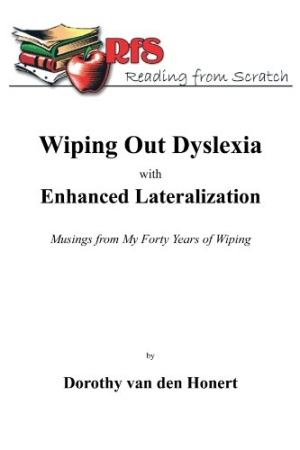Wiping Out Dyslexia with Enhanced Lateralization
Musings from My Forty Years of Wiping
This longtime educator is passionate about leveling the educational playing field so dyslectics can succeed.
Wiping Out Dyslexia with Enhanced Lateralization: Musings from My Forty Years of Wiping by Dorothy van den Honert is, by turns, memoir and biting social commentary. Descriptions of cognitive science set the stage for the author’s explanation of her Reading from Scratch program for teaching dyslectic students. The author also includes her analysis of the program’s effectiveness and a peppering of illustrative vignettes.
Van den Honert taught literacy-challenged junior high school students for eleven years during the 1970s and 1980s, and then served on her community’s school committee for an additional twenty-two years. Dissatisfied with teaching materials available for young people with inadequate reading skills, she delved into neurocognitive research. The scientific finding that “dyslectic children are out of sync with themselves right down the midline of the body” fascinated her. For them, auditory, visual, and haptic signals do not cross from one brain hemisphere to the other simultaneously, as they do for nondyslectics, she asserts; rather, signals cross in one direction 100 to 200 milliseconds faster than in the other direction. According to van den Honert, a misshapen corpus callosum, the bundle of fibers connecting the two hemispheres of the brain, causes this problem.
Van den Honert reasons that if she could teach dyslectics to focus on signals from only one side of their brains, reading problems could be conquered. Based upon this hypothesis, she invented the Reading from Scratch (RfS) program, and published a description of the method in the Journal of Learning Disabilities in 1977. However, in Wiping Out Dyslexia, the author provides little scientific evidence for RfS’s validity.
Clearly, the author is passionate about leveling the educational playing field so dyslectics can succeed. She provides heartwarming stories of youngsters whose lives changed dramatically after experiencing her creative teaching methods, and says, “A three year reading gain in one year of teaching became normal for the boys.” The book also includes invectives against the US education and justice systems.
Van den Honert’s pointed critiques may appeal in particular to teachers and parents dissatisfied with current trends in American education, but her crusty opinions are not likely to turn administrators into fans of her teaching methods. She says, for example, “a fatal mistake in the forties was to abandon teaching spelling rules. Some dingbat once decided that, in his opinion, most of English was irregular, anyhow, so there was no point in teaching spelling rules. And because this misguided theory fit nicely with ‘Whole Language,’ people actually believed it.”
Given that perhaps as much as twenty percent of the population is dyslectic and special education is a costly endeavor, a program that assists students to permanently overcome their disability and gain several years’ reading ability in only one year of instruction would be a godsend. If van den Honert is correct that Reading from Scratch is such a program, then her impassioned argument for educational reform surely should be heeded.
Reviewed by
Nancy Walker
Disclosure: This article is not an endorsement, but a review. The publisher of this book provided free copies of the book and paid a small fee to have their book reviewed by a professional reviewer. Foreword Reviews and Clarion Reviews make no guarantee that the publisher will receive a positive review. Foreword Magazine, Inc. is disclosing this in accordance with the Federal Trade Commission’s 16 CFR, Part 255.

